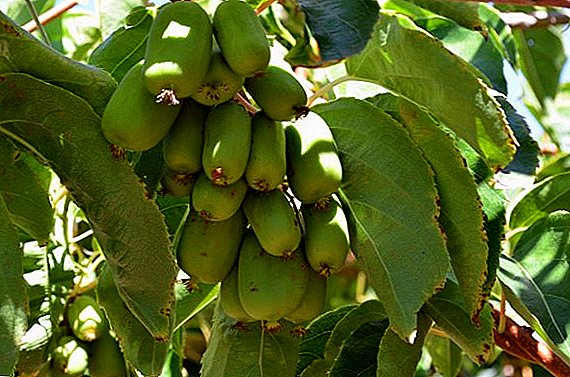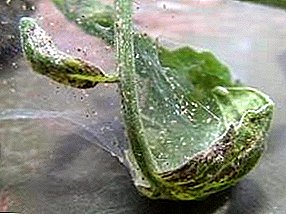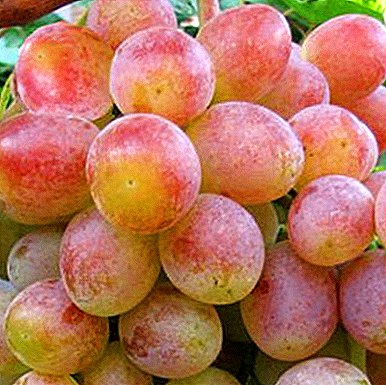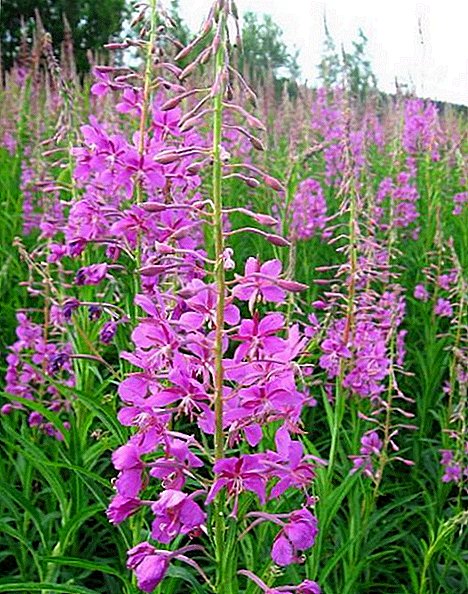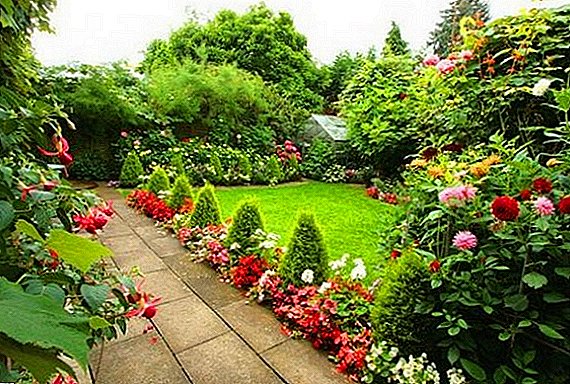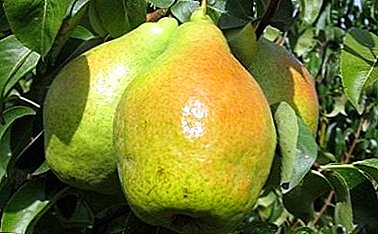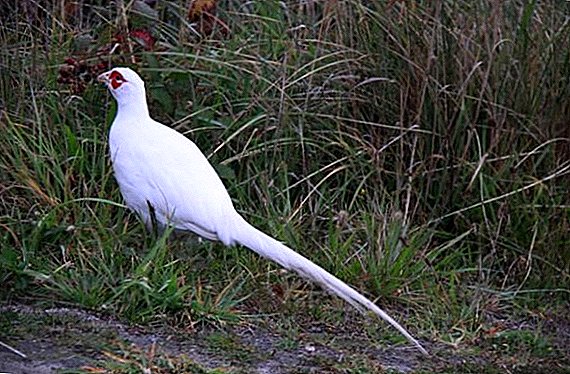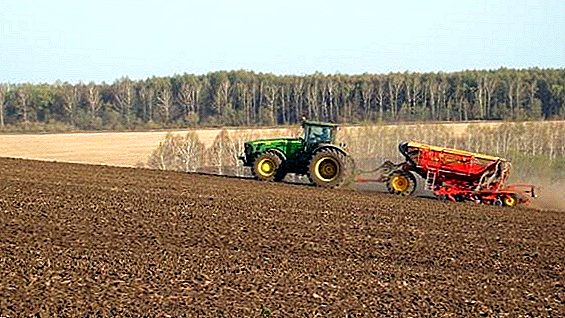 Planting various vegetables on the site, every gardener wants to get a quick, rich harvest, without spending much time and effort on caring for plants. In such cases, the ideal option would be to grow an early, unpretentious tomato "Nastya", which recently has been very popular among vegetable growers. What is remarkable about this tomato and how to take care of it in order to get a good harvest, let's see.
Planting various vegetables on the site, every gardener wants to get a quick, rich harvest, without spending much time and effort on caring for plants. In such cases, the ideal option would be to grow an early, unpretentious tomato "Nastya", which recently has been very popular among vegetable growers. What is remarkable about this tomato and how to take care of it in order to get a good harvest, let's see.
Variety description
Tomato "Nastya" is an early ripe variety of tomatoes of the determinant type, which can grow and bear fruit throughout the season. Tomato belongs to the plants of high yield, as it is possible to gather up to 1.5 kg of fruits from one bush.
The bush is notable for its small growth, up to 70 cm when grown on open ground and up to 90 cm - in a greenhouse, with an erect, rather thick trunk that does not require supports. The plant has small leaves, a simple inflorescence and a stem with stem. Usually, 6 to 8 tomatoes ripen on one stalk, but may be less.
Among the determinant varieties are "Crimson Giant", "Klusha", "Chocolate", "Rio Fuego", "Stolypin", "Sanka", "Apparently Invisible", "Pink Bush F1", "Bobcat", "Bokele F1" , "French Grapevine", "Liana", "Prima Donna", "Beginner", "Balcony Miracle", "Chio-Chio-San".
Since Nastya refers to shtambovyh varieties, not only the bush, but also the entire root system has a compact size. Due to this peculiarity, more bushes can be planted on one square meter of area than tomatoes of other varieties.

The key advantages of the Nastya variety are:
- early fruit ripening;
- high yields;
- unpretentiousness to watering and soil;
- excellent taste of the fruit;
- resistance to most diseases characteristic of tomatoes.
Among the disadvantages of tomato gardeners highlight the need for regular abundant fertilizing with mineral fertilizers, as well as some difficulties with growing seedlings.
Did you know? The variety "Nastya" is the result of the successful work of the Russian breeders Marina Kotelnikova and Sergey Kondakov. It was thanks to their efforts in 2008 that a new type of tomato was obtained, which has early ripening, high yields and excellent fruit taste. Tomato was listed in the State Register in 2012.
Fruit characteristics and yield
Among the main advantages of the variety are its high yield and fruiting during the entire growing season. The plant begins to bear fruit on the 80th day after transplanting.

Fruits have an average size, weight from 120 to 200 g, they are distinguished by a rounded shape, rich red color, dense structure. Tomato has a pleasant, slightly sweet taste, so it can be used both fresh and as part of various dishes, salads, snacks, preservation. Fruits, as a rule, have 4-6 chambers and contain 4-6% of dry matter.
If the main rules of agrotechnics are observed, up to 1.5 kg of fruits can be collected from one bush, and from 1 square meter. m square - up to 12 kg.
Important! In order to achieve better fruiting, it is recommended to regularly remove the fruit from the bush. Tomatoes may be picked during technical ripeness, that is, when they are slightly pinkish or green.
Selection of seedlings
Since the independent cultivation of seedlings requires certain skills and abilities, it is recommended for novice gardeners to acquire it in specialized stores.

It should pay attention to such aspects:
- age. It is better to choose the material, whose age is not more than 45-60 days, and on one bed should be planted seedlings of the same age, which will allow to get a uniform growth, development and fruiting of vegetables;
- growth. It is necessary to give preference to a plant up to 30 cm, with 6-8 true leaves being in the baconization stage;
- stem. In high-quality seedlings, it should be quite thick and durable, and the whole foliage is brightly saturated green, without stains, mold or rot;
- root system. The roots of the plant should be well formed, without obvious visual damage, rot, blackness, etc.
Important! Too green leaves may indicate that the seedlings were grown in an accelerated way by adding too much nitrogen fertilizer. It is better to abandon the purchase of such plants.In addition, when selecting seedlings, it is necessary to conduct its visual inspection. The presence of deformed, shriveled or twisted leaves, black or brown spots on the trunk indicates that the plant is susceptible to infectious or fungal diseases. If there are symptoms of the disease on at least one of the plants, then it is better not to buy any seedlings from this seller at all.
 Twisting leaves of seedlings
Twisting leaves of seedlings
Growing conditions
The most favorable period for planting tomatoes in open ground is considered to be the beginning of May, when the air temperature warms to the level of +12 degrees and above. It is recommended to plant seedlings in the morning when the weather is cloudy, so that it can get a little stronger.
For planting, it is better to select plants aged from 45 to 65 days, on which 6-8 full-fledged leaves and 1-2 flower brushes were formed.
Find out when to plant tomatoes in open ground and what kind of planting is optimal.
The landing process is carried out according to the following algorithm:
- Planting work carried out according to the scheme 70x40, that is, 1 square. m planted 4 plants. To do this, dig a hole with a depth of a spade bayonet and fill it with water.
- After the water leaves, the seedlings are removed from the tank and deepened vertically.
- The root system is sprinkled with a small layer of soil, compost is poured around the stem, the ground is filled with soil and tamped.
- Each bush is watered with at least 1 liter of cold water.

Of course, before planting seedlings should take care of choosing the most comfortable place. For tomatoes, it is recommended to choose a well-lit area, which is reliably protected from cold winds and drafts. Tomatoes take root well on sandy-clay soils that retain moisture well, or on loamy lands enriched with organic components.
Important! For the cultivation of tomatoes varieties "Nastya" not suitable wet and low-lying areas with a close location of groundwater.
Seed preparation and planting
As already mentioned, the cultivation of tomato "Nastya" is carried out by seedling method. Depending on where the sprouts are planned to be planted - in a greenhouse or in the open field, the sowing time will be determined.
In greenhouse cultivation, seeds are sown in a seedling container in late February or early March. When grown on open ground, planting time is better to shift by the end of March - early April.

Tomato seeds should be sown in special boxes or containers, which must have drainage holes that are required to remove excess moisture.
Find out when to sow tomatoes for seedlings, how to carry out preplant treatment of seeds, how to save space and soil when planting seedlings, how to sow and grow tomato seedlings at home.
Planting technology is simple and consists of several stages:
- At the bottom of the container pour 1-2 cm of drainage layer, cover it with a substrate specially designed for the cultivation of tomatoes, and moisten the soil with warm, settled water.
- Sow seeds to a depth of 1-2 cm at a distance of at least 2 cm from each other.
- Sprinkle the planting material with a thin layer of soil, sprinkle with a spray bottle.
- After planting, cover the seed container with a film and place it in a warm, dry room with sufficient lighting, with a temperature of + 22 ... +25 degrees.
- When sprouts appear, remove the film, and move the container to a cooler room, with a temperature of + 17 ... +19 degrees. To carry out moderate moistening of shoots. Overflowing plants can lead to his death.
- When forming on a bush of 2-3 full-fledged leaves, the seedlings dive - they are seated in separate containers, which can be disposable plastic cups or peat pots.

Two weeks before planting in the ground, the shoots must be subjected to hardening. For this, tare with seedlings is carried out to the open air or a balcony for several hours. Gradually, the time spent on the street increase and leave the plants under good climatic conditions for the whole day.
Did you know? There are about 10 thousand varieties of tomatoes. The largest tomato in the world was grown by an American farmer from Wisconsin. The weight of the tomato was 2.9 kg.
Maintenance and care
Good results in increasing the yield of tomatoes gives the correct, timely and competent care.

It includes the implementation of several simple but extremely important activities:
- Watering. Moistening of seedlings should be systematic and moderate - up to 2-3 times a week, depending on weather conditions. For irrigation it is recommended to apply warm, separated water. In no case can not use cold water, as this can lead to rotting of the root system. Particular attention should be paid to watering the plant during its fruiting period, since the lack of moisture affects the condition of the leaves: they begin to curl and turn yellow. At this time, tomatoes are watered every 4 days, spending up to 3 liters of water under one bush. When the fruits begin to ripen, moisture is reduced to once a week.
- Top dressing. The grade "Nastya" is rather exacting to top dressing which needs to be carried out already a week after disembarkation of seedling. To do this, under each bush pour phosphate solution, prepared from 5 liters of water and 15 g of superphosphate. 10 days after the first feeding, the vegetable is fertilized with potash preparations, which improve the taste of the fruit and increase the resistance of the plant to various diseases. To prepare the fertilizer, 15 g of potassium sulfate is mixed with 5 l of water. During flowering, tomatoes are treated with a solution of boric acid: 10 g of acid is added to 10 liters of water. Also, for feeding you can use the ash, which is poured into the ground under the bushes.
- Masking Since the variety belongs to undersized, it does not require a staking process, since only 3-4 branches are formed on the stem. Nevertheless, lower foliage, dried leaves should be removed from the plant, which will improve the growth of the crop and its airing.
- Garter. If necessary, plants use wooden or metal supports for the garter, which are fixed next to each stem with a soft tissue segment.
- Weeding. For better growth and fertility during the active growth of the plant, weeding must be carried out, as well as loosening the soil so that the soil always remains loose and clean.
Check out the method of growing tomatoes without watering.

Disease and pest prevention
Despite the fact that the tomato "Nastya" is resistant to most of the diseases characteristic of tomatoes, yet some of the ailments can affect it.
- And the first thing that a variety fears is a spider mite and whitefly. The formation of white or yellow spots on the lower part of the leaves indicates an attack of the spider mite. If the plant is not treated, then soon it will be covered with white thin web. To cope with the pest will help treatment of the bush with soap and water.
- White scurf on the leaves, similar to flour, yellow or white spots on the foliage, unnatural luster of the leaves, as well as poor fruit ripening are signs of damage to the plant by the whitefly. An effective method of combating the parasite is a solution of Confidor, which is prepared as follows: for 10 l of water, 1 ml of the product.
- In rare cases, tomatoes can attack slugs. Fighting them is simple, just sprinkle the soil around the bush with ashes and crushed hot pepper.
- When growing tomatoes can be faced with such a problem as cracking fruits. In such cases, you should adjust the watering of the plant.
Learn how to look for and what are the ways to combat late blight, cladosporia, fusarium, Alternaria, vertex rot - diseases of tomatoes.For the prevention of various diseases in tomatoes, it is recommended to organize competent care for them, regularly conduct a visual inspection for any damage, and also spray the bushes with special fungicidal preparations.

Harvesting and storage
Tomatoes are harvested both fully mature and in the stage of blanket ripeness, depending on weather conditions and method of application. For fresh consumption, tomatoes are harvested fully matured.
The main thing is not to miss the deadlines for the final harvest, when temperature indicators at night do not fall below + 7-8 degrees. At low temperatures increases the risk of damage to tomatoes of various diseases, which subsequently can cause the rapid deterioration of the fruit with their safety.
In order not to lose the harvest, it is possible to prepare adjika, tomato juice, salted, pickled tomatoes, salads, tomatoes in jelly.
Tomatoes that are picked mature, must be used for three days, green - require stacking for storage. 
When storing fruits should follow these nuances:
- leave for long-term conservation need only those tomatoes that were collected in dry weather and have no damage, stains or inclusions;
- it is desirable to leave the stalk on tomatoes, this will significantly extend the shelf life;
- fruits should be placed in a strong container, covered with soft tissues from the inside;
- choose a dark, dry, well-ventilated place for the crop with a temperature not exceeding +23 degrees and a relative humidity of not more than 80%.
You can make jam, pickle, pickled tomatoes for winter, pickled, Armenian-style green tomatoes, Georgian-style green tomatoes from green tomatoes.
Nastya is an early ripe, unpretentious variety of tomatoes that is great for home cultivation. With proper and timely care, which is sufficient watering, regular feeding and preventive treatment of pests, every gardener can get a rich harvest of tasty, fragrant and delicate tomatoes.
Video: Tomato variety "Nastya"
Tomato "Nastya": reviews




